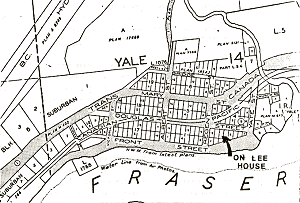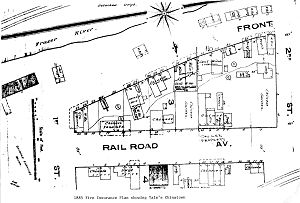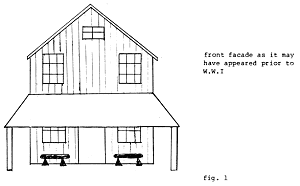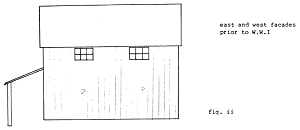
Town Tour
Architectural
Drawings
![]() St. John the Divine
St. John the Divine
![]() On Lee House
On Lee House
![]() Shilson House
Shilson House
Prepared by: Linda J. Eversole
Research Officer
Planning, Research and
Interpretation Division
January, 1984
CONTENTS
Introduction
Historical Background
On Lee House & Store
Structural Examination
Summary
Endnotes
Bibliography
ON LEE HOUSE - YALE, B.C.
The On Lee House, located on Lot 10, Block 2, Yale Townsite, was built about 1880, with a major interior and exterior renovation about 1930. This Preliminary Report has been prepared as a guide for future planning and development of this site. It is subject to clarification through further detailed structural investigation.
The present town of Yale is located on the site of the former Hudson's Bay Company's Fort Yale. Established in 1848, it served as part of the brigade route to Fort Kamloops. However, this route proved impractical and accordingly, the fort was abandoned.
With the discovery of gold along the Fraser River in 1858, Yale became an important settlement. The large numbers of miners heading for the gold fields created a demand for supplies and transportation which brought about the immediate reconstruction of the fort. The town itself was situated in a lucrative mining area, and as head of navigation of the Fraser River and the starting point for trails and waggon roads to the north, was an obvious choice as a supply centre. Because of its important location, James Douglas ordered that the town be properly surveyed and laid out. This order was carried out by the Royal Engineers and by 1859 crown grants were being issued for many of the lots. Douglas noted in his diary at this time,
Fort Yale is a great site for a town, yields large sums of money, probably a million before six months are over.1
As the town grew, commercial firms including stores, warehouses, and hotels were established along Front Street. It was at this time that Yale's Chinatown also began to develop.
Chinese immigration to British Columbia began in 1858, with miners from California making their way to the new gold fields. Soon after, Chinese began immigrating directly from the Kwangtung area of China.2 Some immediately commenced mining, while others went into service occupations such as laundering, cooking, and market gardening. In the towns and settlements that developed the Chinese banded together in their own communities to provide mutual support and assistance, and to allow them to retain much of their own customs and culture. With the building of the Canadian Pacific Railway in the early 1880's large numbers of Chinese labourers were brought to B.C. Many settled in the Chinatown areas of various towns and by the mid-1880's these communities were greatly expanded.
Yale's Chinatown was situated at the east end between the Indian Reserve and the "white" community.
The east end is all life, from the blacksmith shop to the stage stables, and as in that locality the Chinamen have concentrated most of their business places, the foreign tongue is one constant sound.3
The Chinatown area was concentrated around the end of Front and Douglas Streets. The quarter was well established before the era of the C.P.R. construction, but was destroyed by fire in November, 1871.4 With the building of the C.P.R. in the 1880's and the subsequent increase in the Chinese population, construction in this area was greatly accelerated. In the Spring of 1881 the Sentinel reported that a number of large structures including a store, hotel and restaurant, and "extensive" washhouse were in the process of completion.5 These structures were threatened by a fire in 1883 which fortunately was quickly brought under control by the Yale Fire Brigade, with very little loss.6
The community was self-sufficient with its own hospital and doctor, commercial establishments, and cultural and political societies. The 1885 Report of the Royal Commission on Chinese Immigration7 provided a breakdown of the Chinese working population: labourers, 100; store employees, 7; prostitutes, 2; doctor, 1; merchants, 6; making a total of 116 persons.
The Chinese merchants of Yale, because of the nature of their business and interaction with non-Chinese in trade, provided an important function as a liaison between Chinatown and the Caucasian community. They often made contributions towards civic improvements such as street repairs and in one instance made a collective donation of $140 to the Yale Fire
Brigade.8 As senior members of political and fraternal societies, such as the Chee Kung Tong, to which virtually all Chinese belonged in the 19th C., they had considerable influence over other Chinese residents. One of these merchants was On Lee.
On Lee was born in Canton, China about 1830.9 Upon his arrival in British Columbia in the late 1870's he proceeded to Yale where by 1881 he had established a bakery and store.10 Three years later he married Mary Laye in a ceremony officiated by the Grand Master of the Chee Rung Tong (See Appendix II).11 Between 1885 and 1905 they had six children, three boys and three girls. On Lee died on August 2, 1907 and was buried in the family cemetery at Yale.12 After his death his wife and sons continued to operate the store until Mrs. On Lee's death in the 1920's.
The subject property was purchased by On Lee in the Spring of 1880 for $800 from the Oppenheimer Brothers, Merchants.13 The property had originally been crown granted in 1859 to Max William Fifer, and then passed through a series of owners until its purchase by On Lee.14 It is not known whether any buildings were constructed on this property prior to On Lee's occupation, however, it is known that by 1883 he had constructed a store.15 By 1885, as shown on the fire insurance plan he had four buildings on this lot; a grocery, washhouse, and two other buildings identified only as "Chinese".
No contemporary photographs or descriptions of the store during this period have been located. However, local informants have provided a description of the store as they remember it prior to W.W.I, when Mrs. On Lee was the proprietor.16
The entrance was from the front off a small verandah or overhanging porch. The store took up most of the first floor, although there was a small kitchen and possibly a back porch behind. A staircase17 from the store ran to the second from the centre of the building to the right, giving access to the second floor sleeping accommodations. The walls were rough wood, and on the left side was a small shelf or cupboard which held an altar and incense. Long counters extended along each side of the store with shelves behind reaching to the ceiling. The right side held groceries, the left side, dry goods. At the back was a large wood stove, which served as a gathering place for local Chinese who would come to listen to Chinese records played on the gramophone.
The family apparently also sold lumber, hardware, and feed from a building adjacent to the west side of the house.
After Mrs. On Lee's death in the 1920's, the second son, James On Lee, built a store, service station, and hotel complex on the highway and converted the On Lee house and store to his private residence. He continued to operate the new store complex until his death in 1961.
As the other On Lee children died the original house and store passed through the family, finally to the youngest child, Mrs. Kim Young, who sold it to the Provincial Government in 1983 with the hope that it could be preserved as an historic site.
In November, 1983, the author and Don Tarasoff, Head, Research Section, undertook a physical examination of the structure. This examination revealed a "core" unpainted, 2 1/2 storey, board and batten building measuring 20' x 30'. This is likely the 2 storey "grocery" shown on the fire insurance plan of 1885. The location of the present structure roughly corresponds to the location of the grocery, and although the grocery measures approximately 20' x 40', this discrepancy could be accounted for by an overhanging porch at the front and/or an addition or porch on the back.
The physical evidence suggests there were five original windows on the front facade. Four are as shown in the present structure with the front entrance between the lower two windows where the present bay window is now situated. The fifth window was in the attic and is now boarded over.
The back elevation of the house has two original windows on the second floor and an attic window corresponding to the front. The situation of the lower windows and back entrance are not known because the lower portion of the original exterior wall appears to have been removed for the later renovation.
The east and west facades were likely similar to each other in appearance with two windows on the second storey. On the west facade the original two windows have been boarded over and new ones added. Evidence of windows on the first storey has been obliterated although it is likely they were placed directly below the second storey windows.
Local informants are unanimous in stating that the original entrance was at the front where the bay window is now and it has been indicated that a large overhanging porch extended out from the front. Benches were apparently located outside the door. (See fig. 1)
As mentioned, according to local informants, the On Lee store was renovated in the late 1920's or early 1930's as a residence. Probably at this time the bay window was added, and the side porch and entrance constructed. The interior was drastically altered with the addition of V-joint panelling, electrical wiring, new staircase, and a fireplace. At this time the back additions were constructed, and windows enlarged or new ones added.
It has not been determined when the exterior siding was put on. One informant has indicated there may have been siding on the front facade of the store at an earlier period than the 1930 renovation. A more thorough structural examination will reveal more, however, this will involve some damage to the present building i.e. the removal of some exterior siding and interior panelling.
A number of conclusions have been determined in reviewing the research to date and the preliminary structural examination.
l. The On Lee House and Store was probably built between 1880 and 1883, during the Yale Chinatown "building boom". It was a 2 1/2 storey, unpainted, board and batten building with small symmetrically placed windows and a front entrance.
2. Informants claim that before W.W.I the interior was a single room store on the ground floor with an internal staircase giving access to the second storey sleeping accommodations.
3. By 1930 James On Lee had renovated the house/store for a residence by adding an extension to the rear, a bay window to the front, and an enclosed porch on the west. The interior was panelled in V-joint throughout and electricity installed.
The On Lee family owned the house/store and property for 103 years. It is one of the few surviving relics of Yale's Chinatown, and as such, its importance is as a tangible reminder of the town's Chinese community.
1 Ormsby, Margaret. B,C,: A History, Vancouver: McMillan, 1958, pp. 157-158.
2 Willmott, W.E. "Approaches to the Study of the Chinese in British Columbia", B.C. Studies No. 4. Spring 1970 p.38.
3 Inland Sentinel. June 17, 1880, p.2.
4 Colonist, Nov. 19, 1871, p.3.
5 Inland Sentinel, April 21 & 28, 1881, p. 3.
6 Inland Sentinel, Nov. 29, 1883, p. 3.
7 Canada. Sessional Papers. "Report of the Royal Commission on Chinese Immigration" 1885, p. 363-366.
8 Inland Sentinel, Dec. 6, 1883, p.3.
9 Canada. Census - 1881, Reel B-390, District 189.
10 Kamlooops L.T.O., Deed of Land - David Oppenheimer to On Lee, 1880, see Appendix III.
11 Inland Sentinel, Jan. 17, 1884, p.3
12 Ministry of Health. Dep't, of Vital Statistics, Verification of Death - On Lee, see Appendix VI.
13 Abstract of Title, see App. II.
14 Ibid.
15 Inland Sentinel, Aug. 30, 1883, p. 3.
16 Among the informants interviewed were: Mr. Everett Cox and Mr. Sid Clare, long time Yale residents; Mrs. Rim Young, On Lee's daughter; and Mr. Russell Richards, a friend and former business partner of James On Lee.
17 During the structural examination the remains of a staircase on the east side of the interior of the house was noted.
Books and Articles
Con, H., Johnson, G., et al. From China to Canada. Toronto: McClelland and Stewart, 1982.
Gibson, Rev. O. The Chinese in America. Cincinatti: Hitchcock & Walden, 1877
Hibben's B.C. Directory 1877-78.
Lai, David (Chuen-Yan). "Home County & Clan Origins of Overseas Chinese in
Canada in the Early 1880's", B.C. Studies, No. 27, Autumn 1975.
Ma, Ching. Chinese Pioneers. Vancouver: Versatile Publishing Co., 1979.
Ormsby, Margaret. B.C.: A History. Vancouver: McMillan, 1958.
William's B.C. Directory, 1882-83, 1884-85.
Williamson, Frank. "Yale and the Fraser River Canyon", Overland Monthly. Vol. 44, 1904.
Government Documents & Agencies
British Columbia. Legislative Assembly. Report on Oriental Activities.
Victoria: King's Printer, 1927.
British Columbia. Ministry of Attorney-General. Kamloops Land Titles office.
British Columbia. Ministry of Attorney-General. Probate. Wills Index (in PABC - B1990)
British Columbia. Ministry of Finance. Chilliwack Assessment Office.
British Columbia. Ministry of Finance. Tax Assessment Rolls. 1929-1976.
British Columbia. Ministry of Health. Dep't. of Vital Statistics.
British Columbia. Ministry of Provincial Secretary and Government Services. Heritage Conservation Branch. Lillooet-Fraser Heritage Study, 1977.
Canada. Census - 1881. Reel B-390, District 189, A-1 & A-2. (In PABC)
Canada. Immigration Branch. Register of Chinese Immigration, 1887-1908. (In PABC)
Canada. Sessional Papers. Report of the Royal Commission on Chinese Immigration. Vol. XVIII, No. 2. Ottawa: King's Printer, 1885.
Canada. Sessional Papers. Report of the Royal Commission on Chinese and
Japanese Immigration, No. 54. Ottawa: King's Printer, 1902.
Manuscripts
Cumyow, Alexander W. Papers 1888-1935. U.B.C., Special Collections.
Foon Sien (Wong Mun-Po). Papers & Newspaper Clippings 1930's-1950's. U.B.C., Special Collections.
Lee Family Papers. 1895-1939. U.B.C., Special Collections.
Lee, David T.H. History of the Overseas Chinese in Canada. Rough translation. U.B.C., Special Collections.
Ling, Shih-Yuan, Chinese Consul - Vancouver. Letterbook, 1914, U.B.C., Special Collections.
Newspapers
Inland Sentinel
Daily Colonist
Interviews
Mr. Donald Chu, Vancouver, B.C. - June 13, 1983.
Mr. Sid Clare, Yale, B.C. - Dec. 7, 1983.
Mr. Everett Cox, Hope, B.C. - Jan. 5, 1984.
Mr. Russell Richards, Vancouver, B.C. - Dec. 7, 1983
Mrs. Kim Young, Vancouver, B.C. - Aug. 30, 1983.
Home | Contents | Tour | People | Collection | Transportation | Just For Kids! | Team
|
Last updated 31 August 1998. This digital collection was produced under contract to the SchoolNet Digital Collections Program, Industry Canada. Produced by Schoolnet Digital Collections Team. |

|



